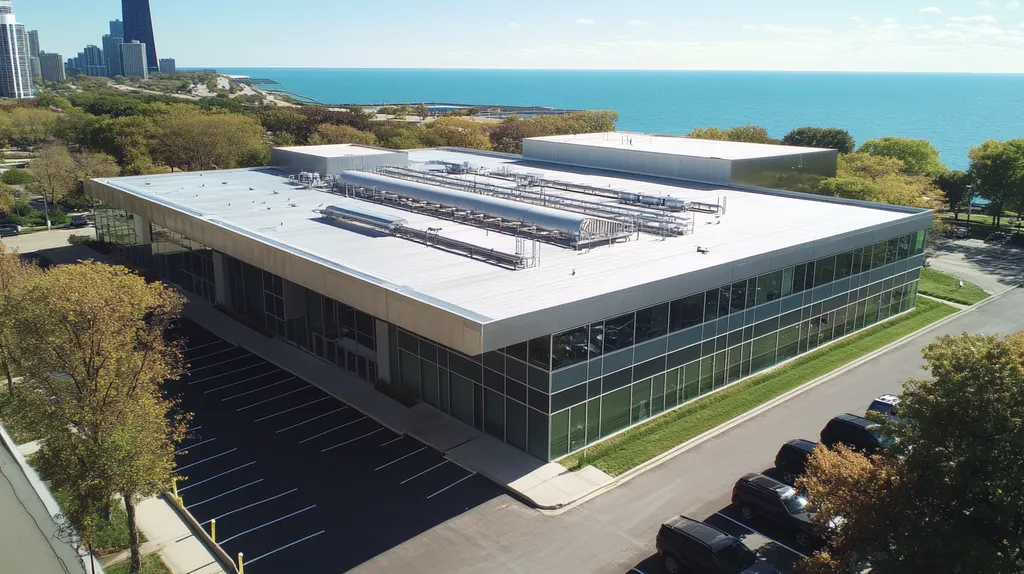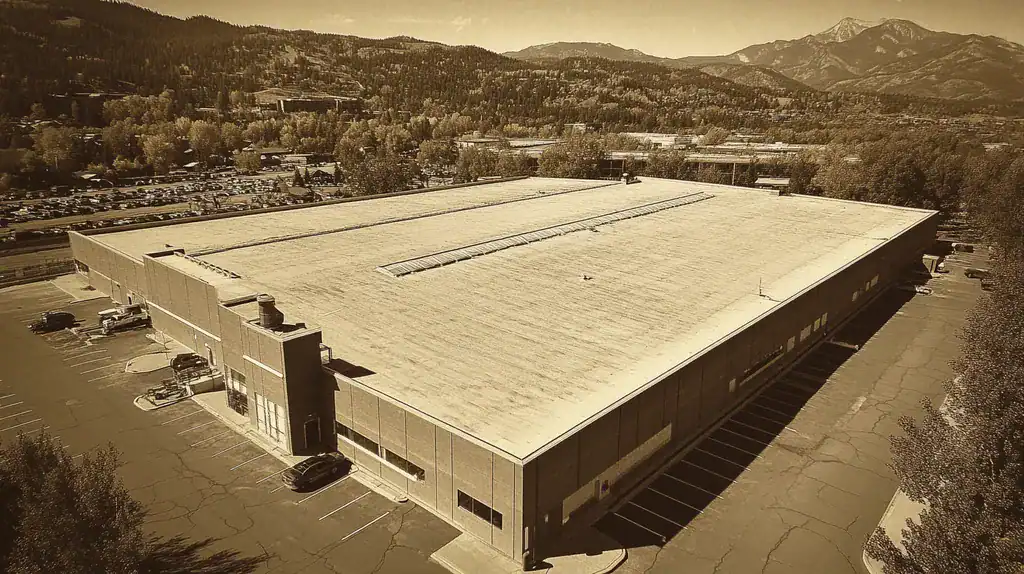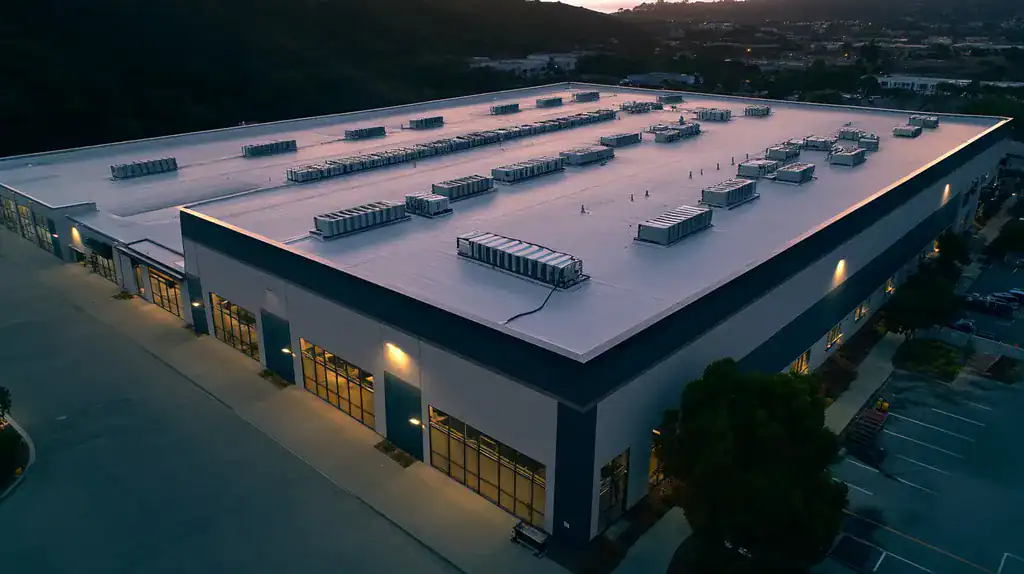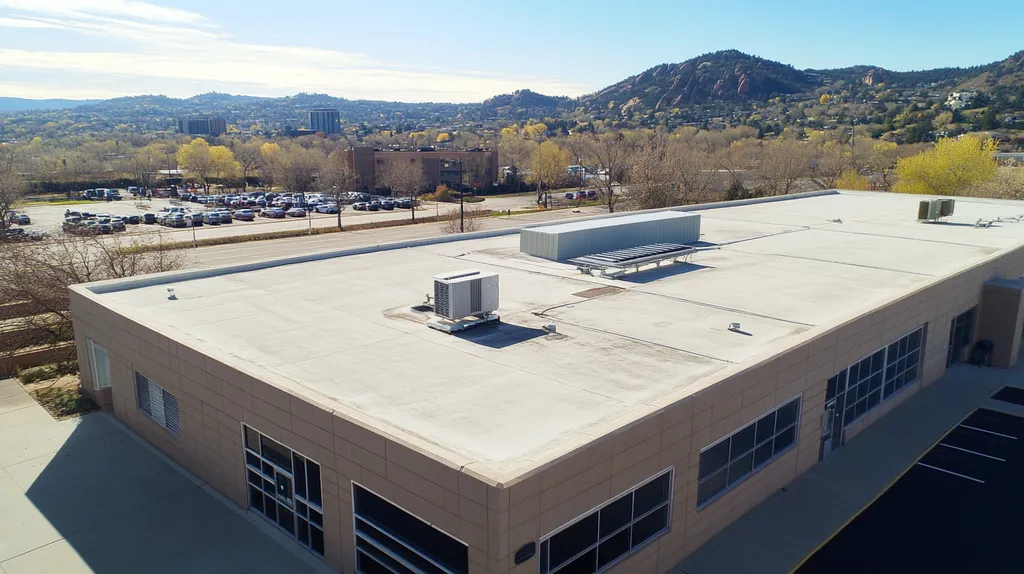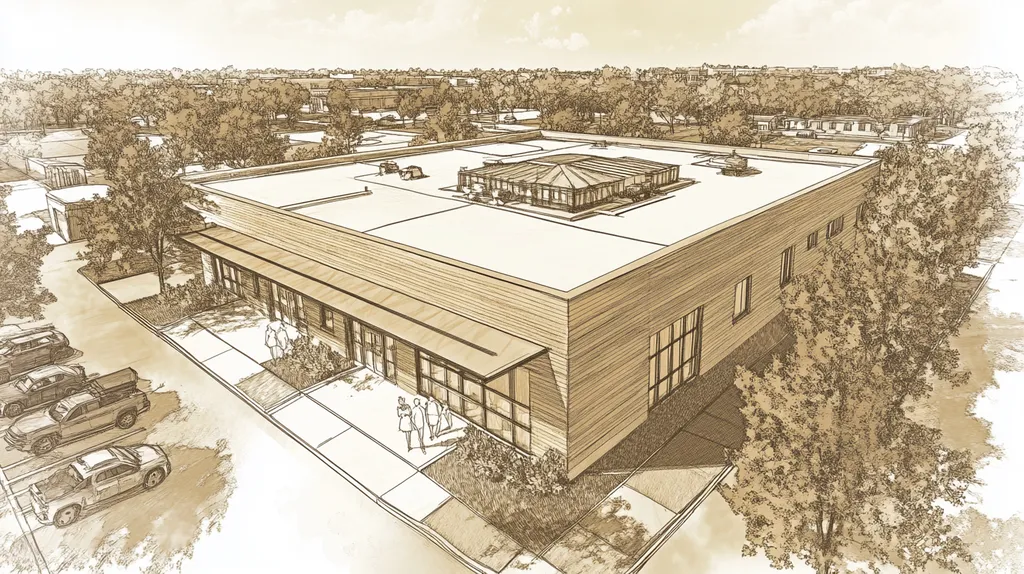Welcome to today’s Battle Royale featuring two roofing heavyweights: “Silicone” in the east corner versus “Polyurethane” in the west!
Tonight’s showdown pits these contenders against each other across six punishing rounds designed to test every aspect of their performance for climate conditions affecting commercial roofs.
At stake? Millions in potential costs, decades of building protection, and the critical performance demands of modern commercial and industrial facilities.
Our professional judging panel will evaluate each round on technical merit, real-world performance, and value delivery. After all six rounds, we’ll declare our ultimate champion.
Ladies and gentlemen, facility managers and building owners… it’s time to rumble!
ROUND 1: INITIAL COSTS & INSTALLATION
When selecting a commercial roof coating, the initial investment encompasses more than just material costs. A typical 20,000-square-foot commercial roof coating project can range from $30,000 to $80,000 – a significant capital expenditure that demands careful consideration of materials, application processes, and project duration.
The right choice between silicone and polyurethane coatings can mean the difference between a smooth, efficient installation and weeks of costly delays and complications. Understanding these factors is crucial for making an informed decision that aligns with both immediate budget constraints and long-term facility management goals.
Material Expenses
Silicone coatings form a strong, waterproof membrane that provides excellent UV resistance and energy efficiency, reflecting up to 90% of UV rays. This superior performance comes at a premium, with costs typically ranging from $3.00 to $4.00 per square foot. (source: Africker Roofing)
Polyurethane coatings present a more economical initial investment, usually costing between $1.50 and $3.00 per square foot. This lower entry point makes them attractive for projects with tight budgets.
While polyurethane offers immediate cost savings, silicone’s superior performance characteristics and longer lifespan often justify the higher upfront investment. For this reason, neither coating claims an ADVANTAGE in this category – it’s a TIE.
Installation Complexity
Installation complexity directly impacts labor costs and project success rates. Silicone coatings offer straightforward application processes, requiring minimal surface preparation and specialized equipment.
Polyurethane installations demand extensive surface preparation, precise temperature and humidity conditions, and multiple coating layers. These requirements increase both complexity and the potential for application errors.
The simpler application process of silicone coatings reduces labor costs and minimizes the risk of installation errors. This gives silicone coatings the clear ADVANTAGE in installation complexity.
Project Timeline
Project duration affects both direct costs and business disruption. Silicone coating installations typically complete in 2-3 days for an average commercial roof, with minimal curing time required.
Polyurethane applications often extend to 4-5 days or longer, requiring specific weather conditions and extended curing periods between coating layers. Weather delays can further extend this timeline.
The faster completion time and reduced weather sensitivity of silicone installations provide significant operational benefits. This gives silicone coatings the ADVANTAGE in project timeline considerations.
ROUND 1 WINNER: SILICONE COATINGS
ROUND 2: DURABILITY & LIFESPAN
The durability and service life of commercial roof coatings directly impact both maintenance budgets and building protection. Studies show that premature coating failures can increase annual maintenance costs by up to 40% while leaving valuable assets exposed to weather damage. Understanding how different coatings perform under various climate conditions is crucial for making cost-effective decisions.
Resistance to UV Radiation
UV radiation represents one of the most destructive forces affecting roof coating performance. Extended exposure can cause material breakdown, color fading, and loss of protective properties.
Silicone coatings maintain their physical properties and flexibility even after years of UV exposure. Their molecular structure naturally resists UV degradation, helping them maintain reflectivity and protection levels.
Polyurethane coatings typically show faster degradation under UV exposure. While they can be formulated with UV inhibitors, these additives eventually deplete, leading to accelerated breakdown of the coating system.
Given their superior UV stability, silicone coatings earn the ADVANTAGE in this category.
Temperature Fluctuation Tolerance
Daily and seasonal temperature changes create expansion and contraction cycles that stress coating systems. These thermal movements can lead to cracking, delamination, and eventual system failure.
Silicone coatings maintain flexibility across a wide temperature range, from -40°F to 350°F. This exceptional elasticity allows them to move with the substrate without compromising their protective properties.
Polyurethane coatings become increasingly brittle at lower temperatures and can soften excessively in high heat. This variable performance increases the risk of coating failure during extreme temperature events.
Silicone’s consistent performance across temperature extremes gives it the ADVANTAGE.
Moisture Resistance
Water infiltration represents the primary threat to roof system integrity. Effective moisture resistance prevents leaks, reduces maintenance costs, and protects underlying building components.
Silicone coatings excel at moisture resistance, forming a seamless membrane that actively repels water. Their hydrophobic nature prevents water absorption even during extended exposure periods.
Polyurethane coatings can be vulnerable to moisture-related issues, particularly during the curing process. Industrial-grade copolymer epoxy variations offer better performance but still generally underperform compared to silicone in long-term moisture resistance. (source: ArmorGarage)
The superior moisture-handling capabilities of silicone coatings earn them the ADVANTAGE.
ROUND 2 WINNER: Silicone Coatings
ROUND 3: PERFORMANCE FACTORS
Climate extremes pose an increasingly critical challenge for commercial roofing systems. Recent industry data shows that improper coating selection leads to a 40% increase in maintenance costs and potentially catastrophic failures during severe weather events. Understanding how different coatings perform under varying conditions has become essential for protecting commercial investments.
UV Resistance
UV radiation represents one of the most destructive forces affecting commercial roof coatings, capable of breaking down protective properties and compromising structural integrity. Extended exposure can lead to coating degradation, color fading, and loss of protective capabilities.
Silicone coatings maintain their physical properties and flexibility even after years of UV exposure. Their molecular structure naturally resists UV degradation, helping them maintain both reflectivity and protection levels over extended periods.
Polyurethane coatings show accelerated degradation under intense UV exposure. While manufacturers incorporate UV inhibitors, these protective additives deplete over time, leading to faster breakdown of the coating system.
Given their superior UV stability and longer-lasting protection, silicone coatings earn the ADVANTAGE in this category.
Temperature Variability
Extreme temperature fluctuations create significant stress on roofing systems through expansion and contraction cycles. These thermal movements can lead to coating failures, particularly in regions experiencing wide temperature swings.
Silicone coatings demonstrate remarkable flexibility across extreme temperature ranges, maintaining their protective properties from -40°F to 350°F. This exceptional elasticity allows them to move with the substrate without compromising their integrity.
Polyurethane coatings become increasingly brittle in cold conditions and can soften excessively during high heat events. This limited temperature tolerance increases the risk of coating failure during extreme weather conditions. (source: NATO STO Meeting Proceedings)
The consistent performance of silicone across temperature extremes gives it the ADVANTAGE.
Moisture Resistance
Water infiltration remains the primary threat to commercial roof integrity, with moisture-related failures accounting for the majority of coating system breakdowns. Effective moisture resistance prevents leaks, reduces maintenance costs, and protects underlying building components.
Silicone coatings excel at moisture resistance, forming a seamless, hydrophobic membrane that actively repels water. This characteristic prevents water absorption even during extended exposure periods, maintaining protection through multiple wet-dry cycles.
Polyurethane coatings show vulnerability to moisture-related issues, particularly during initial curing phases. While industrial-grade variations offer improved performance, they still generally underperform compared to silicone in long-term moisture resistance.
The superior moisture-handling capabilities of silicone coatings earn them the ADVANTAGE.
ROUND 3 WINNER: SILICONE COATINGS
ROUND 4: MAINTENANCE REQUIREMENTS
Maintenance requirements directly impact both operational costs and roof system longevity. Industry data shows that inadequate maintenance programs can reduce a roof coating’s lifespan by up to 50% while increasing annual repair costs by 30%. Understanding the maintenance demands of different coating systems is crucial for developing effective facility management strategies and protecting valuable building assets.
Longevity and Durability
Silicone coatings demonstrate exceptional durability, typically maintaining their protective properties for 15-20 years with minimal intervention. Their molecular stability and resistance to environmental degradation result in consistent performance throughout their service life.
The application environment significantly impacts coating durability and maintenance needs. Application must occur between 50-100°F with relative humidity below 85% to ensure proper curing and long-term performance. (source: Rust-Oleum)
Polyurethane coatings generally require reapplication every 7-10 years due to gradual degradation from UV exposure and weathering. This shorter service life necessitates more frequent maintenance interventions and coating renewal.
Given their superior longevity and reduced maintenance requirements, silicone coatings earn the ADVANTAGE in this category.
Inspection and Repair Requirements
Regular inspections form the foundation of effective maintenance programs. Silicone coatings typically require only annual inspections due to their excellent weathering characteristics and resistance to environmental damage.
When repairs are needed, silicone coatings accept patch applications readily, forming strong bonds with existing material. This characteristic simplifies repair procedures and reduces maintenance complexity.
Polyurethane systems demand quarterly inspections to identify potential issues before they develop into serious problems. Their susceptibility to UV damage and moisture infiltration requires vigilant monitoring.
The reduced inspection frequency and simpler repair procedures give silicone coatings the ADVANTAGE.
Cleaning and Surface Maintenance
Surface maintenance directly impacts coating performance and longevity. Silicone coatings feature smooth, non-porous surfaces that resist dirt accumulation and biological growth.
These coatings typically require only annual cleaning with standard pressure washing equipment. Their chemical stability allows the use of various cleaning solutions without risking coating damage.
Polyurethane coatings often need specialized cleaning protocols and more frequent maintenance due to their tendency to accumulate surface contaminants. Their surface characteristics can make thorough cleaning more challenging and time-consuming.
The simplified maintenance requirements and cleaning protocols give silicone coatings the ADVANTAGE.
ROUND 4 WINNER: SILICONE COATINGS
ROUND 5: SUSTAINABILITY CREDENTIALS
Environmental regulations and market demands are reshaping commercial roofing requirements. Studies show that buildings account for nearly 40% of global energy consumption, making roof coating choices critical for meeting sustainability goals. The stakes are particularly high as more jurisdictions implement strict environmental standards and energy performance requirements.
Environmental Impact
The environmental footprint of roofing materials extends far beyond their initial application. Manufacturing processes, installation requirements, and end-of-life disposal all contribute to a coating’s total environmental impact.
Silicone coatings demonstrate superior environmental performance through their low VOC emissions and minimal waste generation. Their single-coat application reduces material consumption and transportation-related emissions.
Polyurethane coatings typically require multiple layers and contain higher levels of VOCs. Their shorter lifespan results in more frequent replacements, increasing the overall environmental burden through additional manufacturing and disposal cycles.
Given their reduced environmental impact across the product lifecycle, silicone coatings earn the ADVANTAGE.
Energy Efficiency
Roof coatings play a crucial role in building energy performance. Studies indicate that effective roof coatings can reduce cooling costs by up to 30% in commercial buildings.
Silicone coatings maintain their reflective properties throughout their service life, consistently reducing heat absorption and cooling loads. Their stable molecular structure resists degradation that could compromise energy performance.
Polyurethane coatings experience gradual degradation of their reflective properties, particularly in high-UV environments. This deterioration leads to decreased energy efficiency over time.
The sustained energy-saving performance of silicone coatings gives them the ADVANTAGE.
Longevity and Maintenance
Sustainable roofing solutions must demonstrate long-term durability to minimize resource consumption and waste generation. The coating’s ability to maintain performance with minimal maintenance directly impacts its sustainability profile.
Silicone coatings can be sprayed, rolled, or brush applied using standard equipment, offering efficient installation while maintaining durability. Their performance meets rigorous ASTM D 6083 standards, ensuring consistent quality and longevity. (source: Rust-Oleum)
Polyurethane coatings require more frequent recoating and ongoing maintenance, consuming additional resources and generating more waste over their service life. Their complex maintenance requirements increase the environmental impact of long-term operation.
The superior durability and reduced maintenance needs of silicone coatings earn them the ADVANTAGE.
ROUND 5 WINNER: SILICONE COATINGS
ROUND 6: SPECIALIZED APPLICATIONS
Specialized roofing applications in commercial and industrial settings face unprecedented challenges from extreme weather patterns and harsh operating conditions. Recent studies show that 65% of premature roof coating failures occur in facilities with unique environmental stressors, highlighting the critical importance of proper coating selection for specialized applications.
The stakes are particularly high for facilities in extreme climates or industrial zones, where coating failure can lead to extensive damage, operational disruptions, and costly emergency repairs.
Performance in Extreme Temperatures
Temperature extremes and rapid fluctuations create intense stress on roofing systems, demanding coatings that maintain stability across wide temperature ranges. This is particularly critical for facilities in regions experiencing severe seasonal changes or those housing temperature-sensitive operations.
Silicone coatings demonstrate exceptional stability across extreme temperature ranges, maintaining flexibility and adhesion from -40°F to 350°F. Their molecular structure allows them to expand and contract without compromising structural integrity.
Polyurethane coatings exhibit more limited temperature tolerance, becoming brittle in extreme cold and potentially softening in high heat. This characteristic makes them less suitable for applications involving significant temperature variations.
The superior temperature stability of silicone coatings earns them the ADVANTAGE in this category.
Industrial Environment Resistance
Industrial environments present unique challenges including chemical exposure, airborne pollutants, and process emissions. These conditions can rapidly degrade standard coating systems, leading to premature failure and increased maintenance costs.
Silicone coatings offer exceptional resistance to industrial contaminants, maintaining their protective properties even when exposed to harsh chemicals and pollutants. Their inert chemical structure prevents degradation from most industrial exposures.
Polyurethane coatings show increased vulnerability to chemical exposure and industrial emissions. While specialized formulations exist, they generally demonstrate lower resistance to industrial conditions compared to silicone alternatives.
Given their superior resistance to industrial conditions, silicone coatings earn the ADVANTAGE.
High-Stress Applications
High-stress applications, such as facilities with heavy roof traffic or extensive mechanical equipment, require coatings that maintain integrity under constant physical stress. These conditions test both the immediate and long-term durability of coating systems.
Silicone coatings demonstrate excellent tensile strength and elongation properties, allowing them to withstand significant physical stress without failing. Their resilient nature provides consistent protection even in high-traffic areas and under mechanical equipment.
Polyurethane coatings can show vulnerability to physical stress and repeated impact, particularly in areas with wide seasonal temperature variations. Their performance limitations in these conditions can lead to premature coating failure. (source: Armor Garage)
The superior stress resistance of silicone coatings gives them the ADVANTAGE.
ROUND 6 WINNER: SILICONE COATINGS
AND THE WINNER IS…
After six grueling rounds of technical evaluation, we have our verdict…
In a stunning display of dominance, SILICONE COATINGS emerge as our undisputed champion, securing victory in all six rounds! This technical knockout showcases silicone’s overwhelming advantages in durability, UV resistance, moisture handling, and long-term performance.
The champion’s superior performance in extreme temperatures (-40°F to 350°F), exceptional moisture resistance, and minimal maintenance requirements proved decisive factors in this dominant victory. Its sustainability credentials and specialized application capabilities further cemented its position as the heavyweight champion of commercial roof coatings.
However, don’t count polyurethane out completely. In situations requiring lower initial investment or where budget constraints are paramount, polyurethane remains a viable contender, particularly for shorter-term solutions in moderate climates.
IMPORTANT NOTICE: While this analysis reflects general performance characteristics, every building presents unique challenges. Local climate conditions, substrate materials, and specific facility requirements can significantly impact coating performance. Property owners should consult qualified roofing professionals who can evaluate their specific situation and recommend appropriate solutions.
Ladies and gentlemen, in the high-stakes arena of commercial roofing, remember: The true victory comes not just from choosing a champion, but from matching your facility’s specific requirements with the right coating’s strengths. Choose wisely, and may your roof remain forever weathertight!
FREQUENTLY ASKED QUESTIONS
Q. What are the initial costs for a commercial roof coating?
A. The initial costs for commercial roof coatings vary significantly based on materials and application. Projects can range from $30,000 to $80,000 for a 20,000-square-foot roof, including labor and preparation. Choosing the right coating can impact installation efficiency, affecting long-term budget outcomes.
Q. How do durability and lifespan compare for industrial roof coatings?
A. Durability and lifespan are critical for choosing industrial roof coatings. Silicone coatings typically last 15-20 years with minimal maintenance, while polyurethane coatings generally require reapplication every 7-10 years. Understanding these differences helps in planning effective maintenance and budget strategies.
Q. What performance factors affect commercial roof coatings?
A. Performance factors such as UV resistance, temperature variability, and moisture resistance greatly influence the effectiveness of commercial roof coatings. Silicone coatings outperform in these areas, ensuring better weather protection and lower maintenance costs over time compared to their polyurethane counterparts.
Q. How do maintenance requirements differ for silicone and polyurethane coatings?
A. Maintenance requirements vary significantly, with silicone coatings typically needing only annual inspections and minimal cleaning. In contrast, polyurethane coatings demand quarterly inspections to manage potential issues due to their vulnerability to UV damage and moisture exposure. This difference impacts overall facility management costs.
Q. What sustainability credentials should I consider for commercial roofs?
A. Sustainability credentials are essential when selecting coatings for commercial roofs. Silicone coatings generally have lower VOC emissions and longer lifespans, reducing environmental impact. Understanding energy efficiency and maintenance needs will help meet increasing environmental regulations and operational cost challenges.
Q. How do specialized applications affect coating choices for commercial roofs?
A. Specialized applications in commercial roofs must consider extreme temperatures and industrial conditions. Silicone coatings excel in these environments due to their stability, flexibility, and resistance to pollutants. This provides reliability under stress and reduces the risk of premature failures that could increase costs.
Q. What is the impact of climate on commercial roof coatings?
A. Climate significantly impacts the performance of commercial roof coatings. Factors like UV radiation, moisture conditions, and temperature swings can affect durability. Understanding local climate characteristics is crucial for selecting the right coating to ensure optimal protection and longevity of the roof system.

